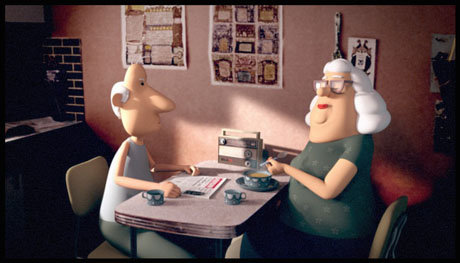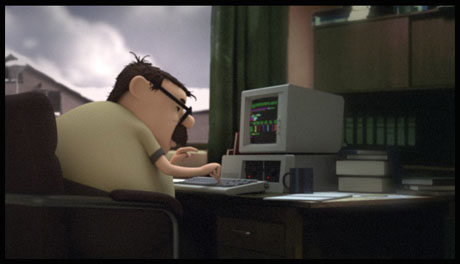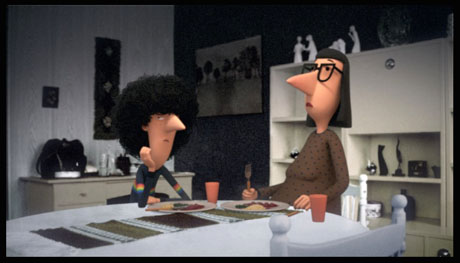
Gísli Darri Halldórsson is the director of Yes-People, one of 10 shorts vying to appear on this year’s Best Animated Short Film Academy Awards ballot. Halldórsson explains how he came-up with and made his quirky, relatable comedy in this Animation Scoop Email Q&A.
Jackson Murphy: There are definitely a lot of “Yes-People” in society – people who say “yes” to a lot of things. Were you inspired by anyone in particular for the concept of your film?
Gísli Darri Halldórsson: The characters in the film are a jumble of people I’ve observed or known over the years. And I wanted to stick with that idea – to just do a story about people and their relationships and not one person/protagonist. The word “já” (yes) was not exactly the concept of the film for me.

GDH: We Icelanders are often nicknamed “yes-people” by our neighbors in Faroe Islands because of how frequently we say “yes”. It’s a word packed with many meanings depending on the way it is expressed. So I was mostly interested in the tonal language that everybody seems to understand regardless of geography. I noticed my daughter picking up on this tonal communication before anything else and I suspect our ancestors communicated like this before words came about. So it was that universal tonal language that made me enthusiastic about making a semi-silent film. A sort of an update to the traditional silent film.
JM: Why did you decide on an apartment building for the main setting?
GDH: It was mostly a practical decision. Working with a short story with so many characters I needed a simple location to avoid unnecessary time to explain geography. And the image of an apartment building also ecoes the idea of mosaic which was the story structure I was trying to build the story onto. I also like how the flats in those blocks have identical layouts and without people they are quite dull and square spaces. Each flat is then transformed by the person that moves in.
JM: Which character storyline was the most difficult to come-up with?
GDH: The red story as I call it – with the oldest couple – changed a bit because I realized I had misunderstood the female character during production. It was a very subtle but a crucial misunderstanding of her personality and that meant I had to re-animate their first shot completely from scratch. Early on I had made sure to do a lot of backstory for them so during production the characters were mostly telling me what to do.

JM: There are some authentic and funny scenes, like the kid playing the recorder. Why do you think authenticity is so important in storytelling?
GDH: Thank you for saying that. Authenticity is a good word. I tried to go for character sincerity which I think leads to authenticity. But it’s hard to reach I think. There is a tendency to go for the joke regardless of authenticity as you say and chasing a joke can become a trap. I’m definitely guilty of that in the past. Authenticity just brings the audience into the experience much more.
JM: I tell people that pretty much every day of my life is different. Do you like routine or variety?
GDH: Routine is so double edged isn’t it? On one hand so boring and dull and on the other hand potentially a blue-print for great achievement or self-betterment. In Iceland we say “dropinn holar steininn” – which roughly translates to “the drop makes a hole in the rock”. My current stance is that “routines” are for people who run in circles while “habits” are for people who make things happen. I just realized though how negative the word “habit” is. But yes! Let’s say I prefer various routines. One that makes you spiral outwards and not stuck in your tracks.

JM: How did your work on Oscar nominated animated short film “Granny O’Grimm’s Sleeping Beauty” and the “Thor” and “Ploey” animated features prepare you to take-on “Yes-People”?
GDH: Well, I also worked on the Oscar nominated animated-short “The Room on the Broom”, which funnily enough was directed by this year’s shortlisted director, Max Lang (and Jan Lachauer). Every job has had some lesson for me but I also think the combination of all those experiences just made me more sure I could direct my own short. The key for me is opinions and aesthetics. I can clearly picture those directors arguing about how to approach a scene and it just fortifies my belief that there is no one way to do it. It’s not an absolute medium. It requires you to put yourself into it and follow your intuition.
JM: You posted a video online talking about your short for the virtual Annecy Film Festival. What scenic location were you in and how did it feel to be a part of Annecy?
GDH: That’s a 5-minute walk from my home in Reykjavík. It’s the city’s coastline often referred to as Grandi. Lovely place! I enjoyed Annecy immensely despite the Covid situation – so thrilled to be accepted! I had been there in 2016 as an audience member and that was such an enriching experience. I hope I can be there in person one day again with my own film.
JM: What would an official Oscar nomination (and a win) mean to you?
GDH: Well, I would certainly be over and around the moon by such recognition. It would definitely fortify me in continuing on my path of telling my own stories. But I think it’ll be best if I enjoy the moment of being shortlisted and keep managing all expectations of further Oscar glory.
- INTERVIEW: Jeff Fowler On “Knuckles” And “Sonic 3” - April 22, 2024
- INTERVIEW: “Inside Out 2” Director And Producer On Pixar Sequel - April 16, 2024
- INTERVIEW: “Puffin Rock And The New Friends” And 25 Years Of Cartoon Saloon - April 10, 2024


 February 26th, 2021
February 26th, 2021  Jackson Murphy
Jackson Murphy  Posted in
Posted in  Tags:
Tags: 






